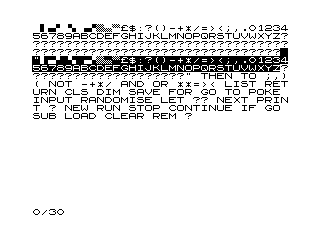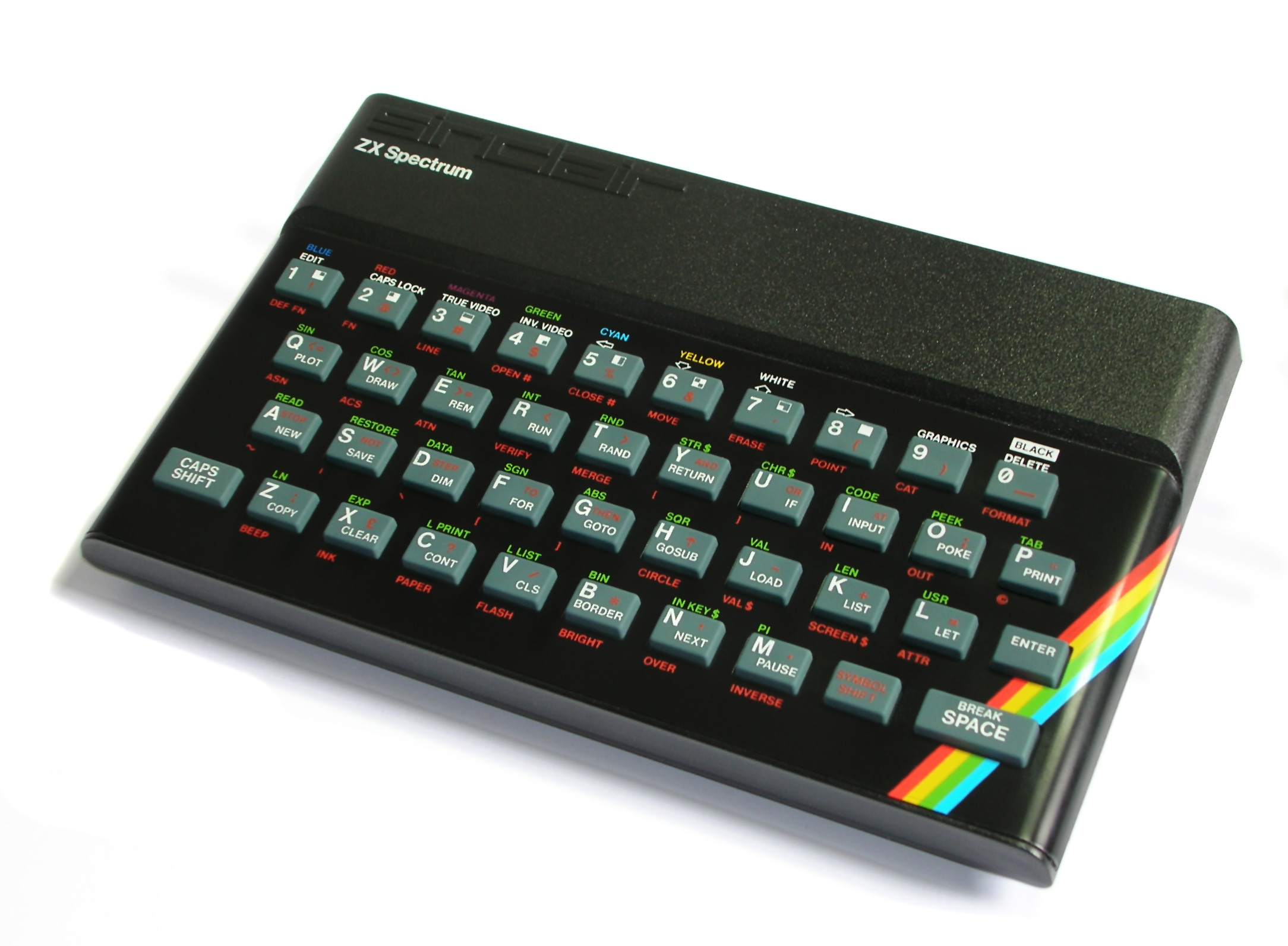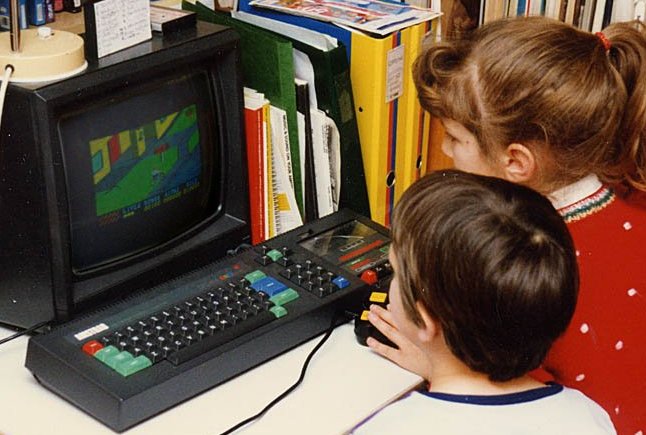|
ZX80
The Sinclair ZX80 is a home computer launched on 29 January 1980 by Science of Cambridge Ltd. (later to be better known as Sinclair Research). It is notable for being one of the first computers available in the United Kingdom for less than a hundred pounds. It was available in kit form for £79.95, where purchasers had to assemble and solder it together, and as a ready-built version at £99.95. The ZX80 was advertised as the first personal computer for under £100 and received praise for its value and documentation. However, it faced criticism for screen blanking during program execution, small RAM size, and the keyboard design. It was very popular straight away, and for some time there was a waiting list of several months for either version of the machine. Name The ZX80 was named after the Z80 processor with the 'X' meaning "the mystery ingredient". Hardware Internally, the machine was designed by Jim Westwood around a Z80 central processing unit with a clock speed ... [...More Info...] [...Related Items...] OR: [Wikipedia] [Google] [Baidu] |
ZX81
The ZX81 is a home computer that was produced by Sinclair Research and manufactured in Dundee, Scotland, by Timex Corporation. It was launched in the United Kingdom in March 1981 as the successor to Sinclair's ZX80 and designed to be a low-cost introduction to home computing for the general public. It was hugely successful; more than 1.5 million units were sold. In the United States it was initially sold as the ZX-81 under licence by Timex. Timex later produced its own versions of the ZX81: the Timex Sinclair 1000 and Timex Sinclair 1500. Unauthorized ZX81 clones were produced in several countries. The ZX81 was designed to be small, simple, and above all, inexpensive, with as few components as possible. Video output was designed for a television set rather than a dedicated monitor. Programs and data are loaded and saved onto compact audio cassettes. It uses only four silicon chips and 1 KB of memory. It has no power switch or moving parts, with the exception ... [...More Info...] [...Related Items...] OR: [Wikipedia] [Google] [Baidu] |
ZX80 Character Set
The ZX80 character set is the character encoding used by the Sinclair Research ZX80 microcomputer with its original 4K Sinclair BASIC, BASIC Read-Only Memory, ROM. The encoding uses one byte per character for 256 code points. It has no relationship with previously established ones like ASCII or EBCDIC, but it is related though not identical to the ZX81 character set, character set of the successor ZX81. Printable characters The character set has 64 unique glyphs present at code points 0–63. With the most significant bit set the character is generated in Reverse video, inverse video; corresponding to code points 128–191. These 128 values are the only displayable ones allowed in the video memory (known as the display file). The remaining code points (64–127 and 192–255) are used as control characters or Sinclair BASIC keywords, while some are unused. The small effective range of only 64 unique glyphs precludes support for Latin alphabet, Latin Letter case, lower case lette ... [...More Info...] [...Related Items...] OR: [Wikipedia] [Google] [Baidu] |
Sinclair BASIC
Sinclair BASIC is a dialect of the programming language BASIC used in the 8-bit home computers from Sinclair Research, Timex Sinclair and Amstrad. The Sinclair BASIC interpreter was written by Nine Tiles Networks Ltd. Designed to run in only 1 KB of RAM, the system makes a number of decisions to lower memory usage. This led to one of Sinclair BASIC's most notable features, that the keywords were entered using single keystrokes; each of the possible keywords was mapped to a key on the keyboard, when pressed, the token would be placed into memory while the entire keyword was printed out on-screen. This made code entry easier whilst simplifying the parser. The original ZX80 version supported only integer mathematics, which partially made up for some of the memory-saving design notes which had negative impact on performance. When the system was ported to the ZX81 in 1981, a full floating point implementation was added. This version was very slow, among the slowest BASICs ... [...More Info...] [...Related Items...] OR: [Wikipedia] [Google] [Baidu] |
Sinclair Research
Sinclair Research Ltd is a British consumer electronics company founded by Clive Sinclair in Cambridge in the 1970s. In 1980, the company entered the home computer market with the ZX80 at £99.95, at that time the cheapest personal computer for sale in the United Kingdom. A year later, the ZX81 became available through retailers, introducing home computing to a generation, with more that 1.5 million sold. In 1982 the ZX Spectrum was released, becoming the UK's best selling computer, and competing aggressively against Commodore and Amstrad. A combination of the failures of the Sinclair QL computer and the TV80 pocket television led to financial difficulties in 1985, and a year later Sinclair sold the rights to its computer products and brand name to Amstrad. Sinclair Research Ltd continued to exist as a one-man company, marketing Clive Sinclair's inventions. History Founding and early years On 25 July 1961, Clive Sinclair founded his first company, Sinclair Radi ... [...More Info...] [...Related Items...] OR: [Wikipedia] [Google] [Baidu] |
Home Computer
Home computers were a class of microcomputers that entered the market in 1977 and became common during the 1980s. They were marketed to consumers as affordable and accessible computers that, for the first time, were intended for the use of a single, non-technical user. These computers were a distinct market segment that typically cost much less than business, scientific, or engineering-oriented computers of the time, such as those running CP/M or the IBM PC, and were generally less powerful in terms of computer memory, memory and expandability. However, a home computer often had better video display controller, graphics and sound than contemporary business computers. Their most common uses were word processing, playing video games, and computer programming, programming. Home computers were usually sold already manufactured in stylish metal or plastic enclosures. However, some home computers also came as commercial electronic kits, like the ZX80, Sinclair ZX80, which were both h ... [...More Info...] [...Related Items...] OR: [Wikipedia] [Google] [Baidu] |
MK14
The MK14 (Microcomputer Kit 14) was a computer kit sold by Science of Cambridge of the United Kingdom, first introduced in 1977 for £39.95. The price was very low for a complete computer system at the time, and Science of Cambridge eventually sold over fifteen thousand kits. The design was unusual in that it used the National Semiconductor SC/MP microprocessor, which was not widely used in this role. The original design was custom, based on a Sinclair calculator as the main input and output device. National Semiconductor offered them the design of National's IntroKit single board computers for free if they agreed to a purchase agreement on the parts, which would be lower than what they could negotiate separately. The original design was dropped in favour of National's offer. Several upgrades for memory were available, allowing a maximum of 2 kB of RAM, as well as a variety of other add-ons. History Design From 1974, Ian Williamson was working at the engineering firm ... [...More Info...] [...Related Items...] OR: [Wikipedia] [Google] [Baidu] |
Static RAM
Static random-access memory (static RAM or SRAM) is a type of random-access memory (RAM) that uses latching circuitry (flip-flop) to store each bit. SRAM is volatile memory; data is lost when power is removed. The ''static'' qualifier differentiates SRAM from ''dynamic'' random-access memory (DRAM): * SRAM will hold its data permanently in the presence of power, while data in DRAM decays in seconds and thus must be periodically refreshed. * SRAM is faster than DRAM but it is more expensive in terms of silicon area and cost. * Typically, SRAM is used for the cache and internal registers of a CPU while DRAM is used for a computer's main memory. History Semiconductor bipolar SRAM was invented in 1963 by Robert Norman at Fairchild Semiconductor. Metal–oxide–semiconductor SRAM (MOS-SRAM) was invented in 1964 by John Schmidt at Fairchild Semiconductor. The first device was a 64-bit MOS p-channel SRAM. SRAM was the main driver behind any new CMOS-based technology fabrica ... [...More Info...] [...Related Items...] OR: [Wikipedia] [Google] [Baidu] |
Electronic Kit
An electronic kit is a package of electrical components used to build an electronic device. Generally, kits are composed of electronic components, a circuit diagram (schematic), assembly instructions, and often a printed circuit board (PCB) or another type of prototyping board. There are two types of kits. Some build a single device or system. Other types used for education demonstrate a range of circuits. These will include a solderless construction board of some type, such as: * Components mounted in plastic blocks with side contacts, that are held together in a base, e.g. Denshi blocks * Springs on a card board, the springs trap wire leads, or component leads, such as Philips EE electronic experiment kits. These are a cheap and flexible option * Professional type prototyping boards, ( breadboards) into which component leads are inserted, following documentation of the "kit". The first type of kit for constructing a single device normally uses a PCB on which components a ... [...More Info...] [...Related Items...] OR: [Wikipedia] [Google] [Baidu] |
SECAM
SECAM, also written SÉCAM (, ''Séquentiel de couleur à mémoire'', French for ''sequential colour memory''), is an analog color television system that was used in France, Russia and some other countries or territories of Europe and Africa. It was one of three major analog color television standards, the others being PAL and NTSC. Like PAL, a SECAM picture is also made up of 625 interlaced lines and is displayed at a rate of 25 frames per second (except SECAM-M). However, due to the way SECAM processes color information, it is not compatible with the PAL video format standard. SECAM video is composite video; the luminance (luma, monochrome image) and chrominance (chroma, color applied to the monochrome image) are transmitted together as one signal. All the countries using SECAM have either converted to DVB, Digital Video Broadcasting (DVB), the new pan-European standard for digital television, or are currently in the Digital television transition, process of conversion. S ... [...More Info...] [...Related Items...] OR: [Wikipedia] [Google] [Baidu] |
Radio Frequency
Radio frequency (RF) is the oscillation rate of an alternating electric current or voltage or of a magnetic, electric or electromagnetic field or mechanical system in the frequency range from around to around . This is roughly between the upper limit of audio frequencies that humans can hear (though these are not electromagnetic) and the lower limit of infrared frequencies, and also encompasses the microwave range. These are the frequencies at which energy from an oscillating current can radiate off a conductor into space as radio waves, so they are used in radio technology, among other uses. Different sources specify different upper and lower bounds for the frequency range. Electric current Electric currents that oscillate at radio frequencies (RF currents) have special properties not shared by direct current or lower audio frequency alternating current, such as the 50 or 60 Hz current used in electrical power distribution. * Energy from RF currents in conduct ... [...More Info...] [...Related Items...] OR: [Wikipedia] [Google] [Baidu] |
RF Connector
An RF connector (radio frequency connector) is an electrical connector designed to work at radio frequencies in the multi-megahertz range. RF connectors are typically used with coaxial cables and are designed to maintain the shielding that the coaxial design offers. Better models also minimize the change in transmission line impedance at the connection in order to reduce signal reflection and power loss. As the frequency increases, transmission line effects become more important, with small impedance variations from connectors causing the signal to reflect rather than pass through. An RF connector must not allow external signals into the circuit through electromagnetic interference and capacitive pickup. Mechanically, RF connectors may provide a fastening mechanism ( thread, bayonet, braces, blind mate) and springs for a low ohmic electric contact while sparing the gold surface, thus allowing very high mating cycles and reducing the insertion force. Research activity in ... [...More Info...] [...Related Items...] OR: [Wikipedia] [Google] [Baidu] |








